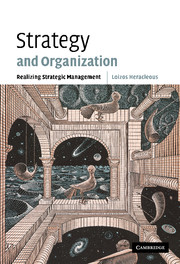Book contents
- Frontmatter
- Contents
- List of figures
- List of tables
- Preface
- I Bases of strategic management
- II Realizing strategy
- 5 The complexities of strategy implementation
- 6 Organizational culture and strategic change processes
- 7 The role of organizational discourse in understanding and managing strategic change
- 8 Strategic change processes: an organization development approach
- III Current themes and applications
- Index of names
- Index of subjects
- References
6 - Organizational culture and strategic change processes
Published online by Cambridge University Press: 11 May 2010
- Frontmatter
- Contents
- List of figures
- List of tables
- Preface
- I Bases of strategic management
- II Realizing strategy
- 5 The complexities of strategy implementation
- 6 Organizational culture and strategic change processes
- 7 The role of organizational discourse in understanding and managing strategic change
- 8 Strategic change processes: an organization development approach
- III Current themes and applications
- Index of names
- Index of subjects
- References
Summary
This chapter considers in depth in one facet of the organizational action view, the organizational paradigm, which provides the context for strategic choices and actions. In chapter 2 it was suggested that at the descriptive level, paradigms include epistemological considerations (knowing what to know), and methodological considerations (knowing how to know). At the normative level, they include values (end purposes) and moral systems justifying these values (Litterer and Young 1984: 249–250). Within strategic management, the concept of organizational paradigm was defined by Johnson (1987, 1988) in terms of organizational culture, as “the set of beliefs and assumptions, held relatively common through the organization, taken for granted, and discernible in the stories and explanations of the managers, which plays a central role in the interpretation of environmental stimuli and configuration of organizationally relevant strategic responses … both intended and realized strategy are likely to be configured within the parameters of the paradigm” (Johnson 1988: 84–85).
This chapter employs a processual approach to examine the nature of organizational culture and its effects, focusing on the close interrelationship between culture and strategic change. The case discussion illustrates how a strategic re-direction involving market repositioning and substantial growth can also entail significant cultural and organizational changes. The discussion suggests that rather than aiming for wholesale cultural change, an organization should recognize what aspects of the culture need to change and what aspects need to be nurtured.
- Type
- Chapter
- Information
- Strategy and OrganizationRealizing Strategic Management, pp. 87 - 111Publisher: Cambridge University PressPrint publication year: 2003



